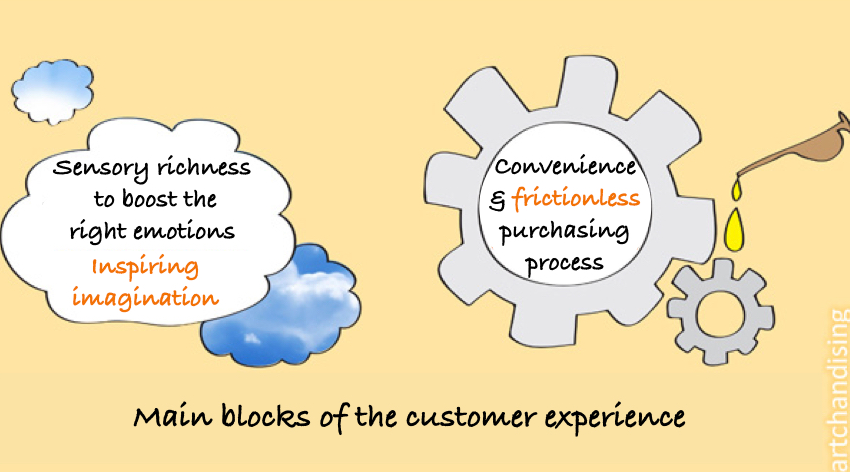You walk into the supermarket one evening after a hard day at work. You are frankly exhausted. You have just been to pick up your two kids from school – gorgeous, the pair of them, but they’ve had an argument and now won’t stop crying. But where is the children’s food section? Oh, they’ve moved it! You ask a shelf stacker who, barely looking at you, disinterestedly points to the new location of the kids’ food section. You eventually find what you are looking for but, when you get to the checkout, you are faced with a queue ten people long. There are no two ways about it, today is not your day. You can’t take any more, so you leave the trolley where it is, grab the kids and walk out. On your way to the car, you take out your smartphone, order food to be delivered home and swear that you will never go back to that supermarket again.
Let’s repeat the scene
I walk into the supermarket one evening after a hard day at work. I am frankly exhausted. I have just been to pick up your two kids from school – gorgeous, the pair of them, but they’ve had an argument and now won’t stop crying. At the entrance, I see a monitored play area for kids and they ask if they can stay there while I shop. They are both smiling again. I head over to the kids’ food section where I find a notice telling me where it has been relocated. A shelf stacker notices that I hesitate and offers to accompany me with a smile. The music is not abrasive and there is a nice atmosphere. My wife is coming back from a trip tonight so I decide to surprise her with one of those cheese selections she likes so much. Next to the cheese, I see a bottle of wine that would go with it perfectly. She’s worth it! She’ll love the surprise. I make my way over to the checkout where there is no queue and I scan the items myself and then pay. Right, now to pick the kids up. Look how lovely they are! I head home in no time at all to get there before my wife arrives.
The shopping experience
The situations described above are the same but with remarkably different outcomes.
This issue is hugely important for businesses because the same soft drink tastes different depending on where you drink it (try it if you don’t believe me). Therefore, a customer’s predisposition, price sensitively and actual shopping behaviour can end up varying greatly depending on how they feel as they shop.
We speak about the “shopping experience”, a term used casually with as many different definitions as there are articles written on the topic.
There was a long-established theory about how consumers decide what to buy, for instance as proposed by Court et al.(2009), who state that customers consider a range of goods/brands to buy, evaluate each of them based on their characteristics and choose one. After using it, they develop expectations for the next shopping process. However, we now know that the vast majority of decisions, including shopping choices, are made unconsciously. In other words, consumers do not create a mental spreadsheet of pros and cons.
The are two key methods not only for improving customers’ shopping experience, but also for increasing the average spend and getting them to come back:
- Reducing effort.
- Stimulating their imagination.
Less effort required, please
In an article published in 2010 in Harvard Business Review (Dixon, Freeman & Toman), the authors argue that we do not maintain customer loyalty by offering an excellent service, but rather we lose it when we give them a bad service. Customer loyalty is not achieved by delighting them but rather by reducing the effort they have to make.
This argument is along the same lines as the theory put forward by Blake Morgan (2015), who uses a highly illustrative example to capture this situation: “Can you imagine a customer climbing up 1,000 stairs to reach you for help only to be told they need to go back down the staircase and climb another one?” Many customers feel this way, for instance, when they have to contract telephone packages and similar services.
It is often the case that the efforts that customers have to make are not detected because they are considered to be ‘normal’: queues, unintelligible information, not being able to locate products, doubts caused by excessive options, unsuitable timetables, sales assistants that can’t answer your questions or who don’t give you the time of day, etc. The effortless shopping experience is not simply a question of the points of interaction between customers and the company, but rather it involves the customers’ entire “journey from start to finish” (Rawson, Duncan & Jones, 2013), including the phase before and after going into the store (whether it is physical or digital).
In the digital world, a click is an example of an effort. Each click reduces the conversion rate by 20%. In other words, if a potential customer has to click five times, it is highly likely that they do not end up making the purchase.
Other statistics show that a shopping experience involving lots of effort for the customer means a high risk of losing them. According to research conducted by Avaya into the impact of customer effort (Wilson, 2014), a bad experience has greater capacity to negatively influence future shopping behaviour than a good experience to have a positive affect. Looking at it from a different perspective, according to a study by McKinsey cited in Blake (2015), companies that focus on providing an effortless shopping experience reap positive rewards, with an increase in revenue of10-15%.
The statistics are closely linked to human biology. When we are faced with problems when shopping, we need to pay conscious attention, which means our slow cortex is activated and we consume high levels of glucose. As a result, we get tired and eventually get fed up. Our brain likes being on ‘automatic pilot. It loves routine (which should not be confused with boredom).
Therefore, the best purchasing decision is the one in which no decision is required.
The rise to power of imagination
Imagination makes us human, as we are the only animal that can imagine. Imagination is the capacity to picture in one’s mind things that are not present for our senses at that time (Robinson, 2006).
When we do something that we like, our brain generates dopamine and we feel good. The latest research (Kent Berridge, 2014) shows that more dopamine is generated when we are preparing or imagining something that we like than when we actually experience it. This is known as the brain’s ‘as if circuit’: the same parts of the brain are activated when we imagine something pleasant as are activated when we are actually enjoying it.
The interesting thing is that retail can act as this moment of preparation/imagination of subsequent enjoyment. To do so, the store must not simply be a transactional space (I swap you a nice bottle of wine for some money), but rather in must be a launch pad for the customers’ imagination. This is achieved through stimuli that trigger certain emotions and make customers visualize a future moment of enjoyment, such as a family meal next Sunday.
If the imagination is triggered, I can assure you that revenue will rise.
One experience and two roles
We have seen that, if we want customers to choose us repeatedly, we have to ensure that we make things easy for them and that they can make their purchase with hardly any effort. We have to be engineers of frictionless shopping processes.
However, we also have to be scriptwriters, creating a sequence of sensations (the shopping process) in such a way that their imagination generates the sense of wellbeing that dopamine gives.
In short, we have to take on two roles, firstly as engineers and then as scriptwriters of an exciting story. It is well worth the effort.
___________________________
Bibliography
- Castro, D.C. & Berridge, K.C. Advances in the neurobiological bases for food ‘liking’ and ‘wanting’. Physiology & Behavior, 136, 22-30, 2014.
- Court, D., et al. (2009) The consumer decision journey. McKinsey, June.
- Dixon, M., Freeman, K. & Toman, N. (2010) Stop trying to delight your customers. Harvard Business Review, July.
- Morgan, B. (2015) Want a powerful customer experience? Make it easy for the customer. Forbes, 13th January.
- Rawson, A., Duncan, E. & Jones, C. (2013) The truth about customer experience. Harvard Business Review, September.
- Robinson, K. (2006) Out of our minds: Learning to be creative. TEDTalks, February.
- Wilson, M. (2014) Avaya Customer Effort Impact Study Reveals the Cost of Inconvenience. Avaya.
___________________________
Lluis Martinez-Ribes
Source: Código 84, number 188
June 2015




